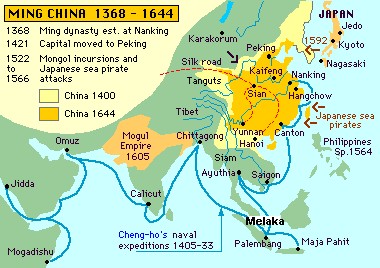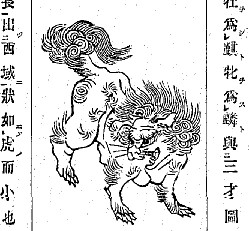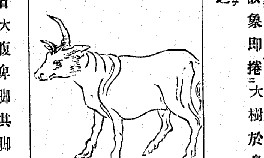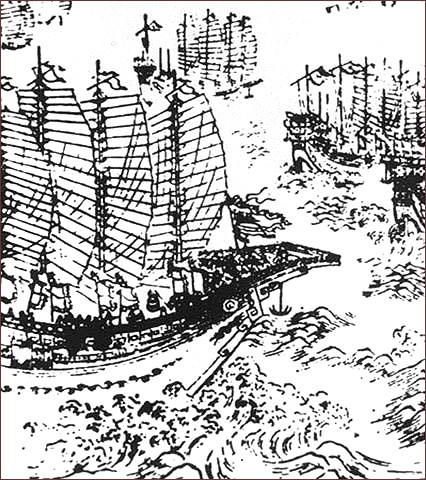To next page
Ma Huan's: Ying-yai Sheng-lan : (The overall survey of the ocean's shores) (1433)
------------------------------
Taken from: F. Sezgin ; Chinese sources on Islamic countries
The translation of : Ma Huan's: Ying-yai Sheng-lan

Left: a page from the Manuscript: it shows the section on Champa; a kingdom in Vietnam.
When he goes out (the Sultan) in a carriage there is an escort of elephants.
(other manuscripts read: there is a mounted escort)
..... And there our people were able to buy .... and such things as golden amber, rose-water, lions, patterned fulu (zebra), golden-spotted leopards, camel-fowls (ostrich) and white pigeons..... and these things were brought home.
They have red sandal-wood, rose-water, magnolia flowers, white grapes. Here also is found the patterned fu-lu, the white camel-fowl with black markings, and the big tailed hornless sheep. (one manuscript adds) (The lion, the ch'i-lin, and the gold spotted leopard) Hua-fu-lu : the animal is about the size of a mule; its body and face are white, lined with dark stripes, which begin in the middle of its forehead, and are distributed at regular intervals over its whole body and down its legs, just as if they painted. The giraffe is also found in this country : its fore legs are nine feet high, and its hind legs about six feet; its neck is sixteen feet long; owing to its fore-quarters being high and its hind quarters low it can not be ridden. It has two short horns at the side of its ears; the tail is like that of a cow, and the body like that of a deer; the hoof is divided into three sections, the mouth is flat, and it feeds on millet and pulse. The lions resemble tigers; they are black and yellow, but without stripes; they have large heads, wide mouths, and pointed tails, on which hang tufts of long black hair; their roar is like thunder, and when heard by other beasts, these latter crouch with fear and dare not stir. Truly this is the king of beasts, says the traveler.
Their houses are built of stone, roofed in with tiles or earth; some of their buildings are forty to fifty feet high, and have three stories.
Their king, grateful for the condescension shown him by the Chinese Emperor, had specially made for His Majesty two gold enameled belts, set with pearls and precious stones. These, with a cap of gold, rubies, and every other kind of precious stones, two rhinoceros horns, and a letter written on gold leaf, were sent as tribute by our fleet on its homeward voyage.
In the Chang -Sheng version of this book the following is added after the description of the lion.
There is also found the ts'ao shang fei and by the natives ya-kuo-shih. It is like a big cat in size, the whole body is like that of a tortoise shell cat. It has black ears. It is gentle and kind, not fierce like the lion and the leopard. When animals see it they prostrate themselves to the ground; it is the king of the animal kingdom.


The king of this country, too, took a ship and loaded it with lions, ch'i-lin, horses, pearls, precious stones, and other such things, also a memorial to the throne (written on) golden leaf; (and) he send his chiefs and other men, who accompanied the treasure-ships dispatched by the emperor, which were returning from the Western Ocean; and they went to the capital and presented tribute.
In his description of Mecca
They bought all kinds of unusual commodities, and rare valuables, ch'i-lin, lions, camel-fowls, and other such things; in addition they painted an accurate representation of the Heavenly Hall, (the Ka'ba) and they returned to the capital.
In his description of Dhofar
Before and behind (the Sultan) a detachment on elephants, camels, and horses, accompany him, all playing on pi-li and so-na. (other manuscripts read: a detachment mounted on camels and horses....)
----------------------------------------------------------------------------------------------------------------------------
